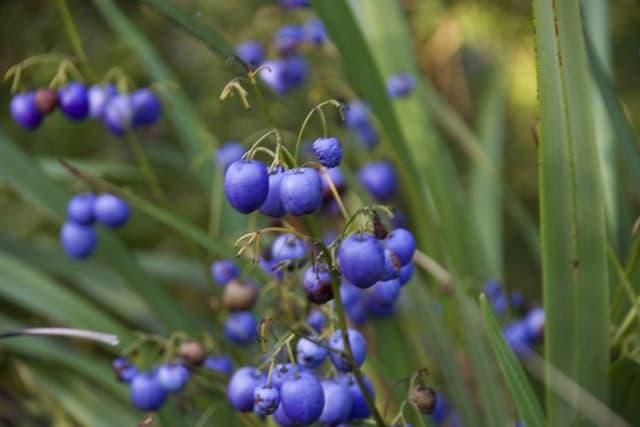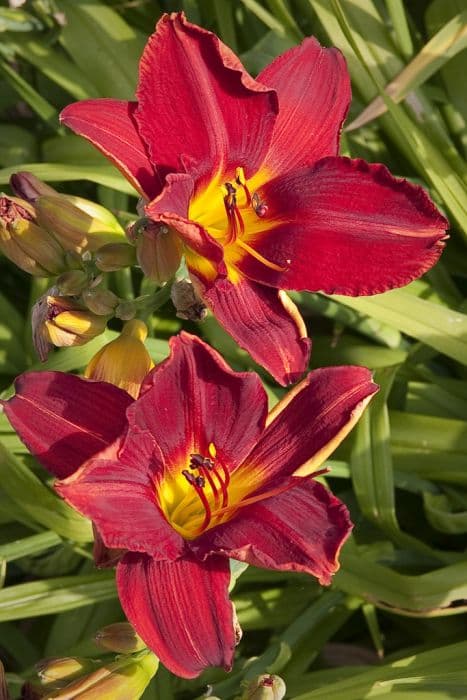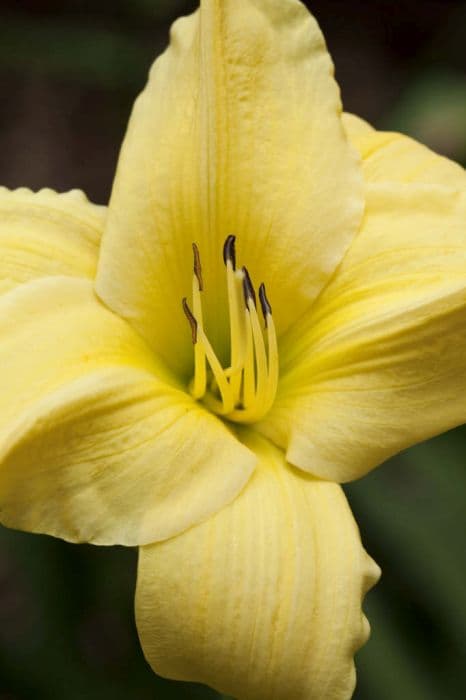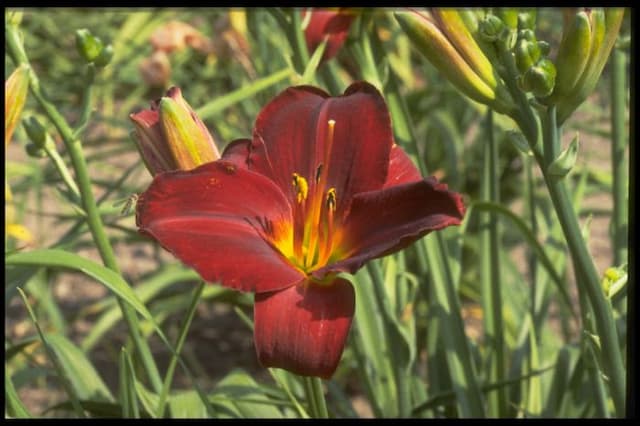Daylily 'Helle Berlinerin' Hemerocallis 'Helle Berlinerin'

ABOUT
'Helle Berlinerin' is a grassy-leaved perennial to 70cm in height, with rounded cream flowers, 13cm in width, with yellow throats, the inner segments with frilled margins
About this plant
 Names
NamesFamily
Hemerocallidaceae
Synonyms
Daylily
Common names
Hemerocallis 'Helle Berlinerin'.
 Characteristics
CharacteristicsLife cycle
Perennials
Foliage type
Deciduous
Color of leaves
Green
Flower color
Varies
Height
2-3 feet (0.6-0.9 meters)
Spread
18-24 inches (45-60 centimeters)
Plant type
Herb
Hardiness zones
3-9
Native area
Asia
Benefits
 General Benefits
General Benefits- Aesthetic Appeal: Adds vibrant color and beauty to gardens with its attractive blooms.
- Pollinator Friendly: Attracts bees, butterflies, and other beneficial insects that pollinate plants.
- Low Maintenance: Requires minimal care once established, making it a good choice for busy gardeners.
- Drought Tolerance: Can withstand periods of low water once established, suitable for xeriscaping.
- Rapid Growth: Quickly forms clumps that can be divided to propagate or control spread.
- Long Blooming Season: Provides flowers for an extended period, often from early summer to fall.
- Versatility: Suitable for a variety of garden designs, from borders to mass plantings.
 Medical Properties
Medical PropertiesThis plant is not used for medical purposes.
 Air-purifying Qualities
Air-purifying QualitiesThis plant is not specifically known for air purifying qualities.
 Other Uses
Other Uses- The petals of the daylily can be used to add color to salads and dishes as an edible garnish, offering a mild, slightly sweet flavor.
- Daylily buds can be blanched and served as a vegetable similar to green beans, providing a unique texture and taste to meals.
- Dried daylily petals are sometimes used to infuse oils and vinegars, imparting a floral note to these condiments.
- Daylily flowers can be battered and fried to make fritters, serving as an unusual and decorative appetizer or snack.
- The plant can be used in companion planting to attract pollinators such as bees and butterflies, which benefit the surrounding garden.
- Daylily tubers are edible when cooked and can be prepared similarly to potatoes for a starchy, nutritious addition to the diet.
- The fibrous leaves and stems of the daylily can be used as natural twine or woven to create small crafts or garden ties.
- Daylily blossoms can be frozen in ice cubes to create visually striking additions to cold beverages during summer events.
- Candied daylily petals can serve as a unique decoration for cakes and desserts, offering both visual appeal and a subtle flavor.
- Daylily plants can be used in permaculture designs as dynamic accumulators due to their deep roots that can help cycle nutrients.
Interesting Facts
 Feng Shui
Feng ShuiThe Daylily is not used in Feng Shui practice.
 Zodiac Sign Compitability
Zodiac Sign CompitabilityThe Daylily is not used in astrology practice.
 Plant Symbolism
Plant Symbolism- Daylily - Transience: The name Hemerocallis comes from the Greek words 'hemera' (day) and 'kallos' (beauty), indicating the brief lifespan of each bloom, typically lasting only for a day, symbolizing the fleeting nature of beauty and the ephemeral quality of life.
- Daylily - Motherhood: In Chinese culture, daylilies are associated with motherhood and the nurturing aspects of parenting, perhaps due to the plant's ability to produce numerous offspring (new buds).
- Daylily - Forgetfulness: The flower is also a symbol of forgetfulness or loss, in the sense of leaving behind the past, given its fleeting bloom cycle where each flower is quickly replaced by another.
- Daylily - Fertility: The daylily can represent fertility or abundance due to its prolific nature and the large number of flowers it can produce throughout its blooming period.
 Water
WaterDaylilies should be watered deeply and thoroughly to encourage root growth. The frequency of watering will depend on your climate and soil type, but as a rule of thumb, daylilies should receive at least one inch of water per week. If you're using a watering can or hose, this equates to roughly 0.6 gallons per square foot per week during active growth, which is usually in the spring and early summer. Ensure that the soil is moist but well-drained, and in the absence of rain, additional watering may be necessary to meet their needs, especially during hot, dry periods.
 Light
LightDaylilies prefer full sunlight to thrive and bloom profusely. They will perform best when they receive at least 6 to 8 hours of direct sunlight per day. If you plant them in an area that gets partial shade, they will still grow, but the number and size of blooms may be reduced. Therefore, the best spot for daylilies would be in an open area with ample access to sunlight throughout the day.
 Temperature
TemperatureDaylilies are versatile and resilient to a wide range of temperatures but they grow best in moderate conditions. They can tolerate temperatures down to around 20°F but should not be exposed to prolonged periods of extreme cold. During the growing season, daylilies prefer temperatures between 60°F and 80°F. They are heat tolerant and can survive highs up to around 90°F, but consistently high temperatures may cause stress to the plants.
 Pruning
PruningPruning daylilies involves removing dead or spent flowers and stalks to promote a tidy appearance and encourage further blooming. Deadheading, or cutting off the dead flowers, can be done throughout the blooming period. After flowering, cut back the flower stalks to the base of the plant. A more substantial pruning can occur in late fall or early spring when the foliage can be cut back to the ground to encourage fresh growth. Pruning is not typically required more than once a year.
 Cleaning
CleaningAs needed
 Soil
SoilDaylilies thrive in well-draining, fertile soil with a pH of 6.0 to 6.5. A mixture of garden soil, compost, and a bit of sand or perlite to improve drainage makes an ideal soil mix for the Hemerocallis 'Helle Berlinerin'.
 Repotting
RepottingDaylilies, including Hemerocallis 'Helle Berlinerin', don’t usually require frequent repotting and can thrive outdoors in the ground without the need for repotting. However, if grown in containers, they should be repotted every 3 to 4 years.
 Humidity & Misting
Humidity & MistingDaylilies are quite adaptable and will do well in average garden humidity. They don’t have specific humidity requirements, making the Hemerocallis 'Helle Berlinerin' suitable for a wide range of outdoor climates.
 Suitable locations
Suitable locationsIndoor
Place in bright, indirect light and ensure pot has drainage.
Outdoor
Plant in sun to part-shade, ensure good drainage.
Hardiness zone
3-9 USDA
 Life cycle
Life cycleThe Hemerocallis 'Helle Berlinerin', commonly known as the Daylily 'Helle Berlinerin', starts its life cycle when a seed germinates in well-drained soil in early spring, or when a division of an existing plant is planted. After germination, the seedling grows into a juvenile plant with a small rosette of leaves. As the plant matures, it forms a larger clump with multiple strap-like leaves and establishes a strong, fleshy root system. In late spring to early summer, the Daylily 'Helle Berlinerin' produces tall flower scapes bearing large, showy flowers that typically last just one day each, which is characteristic of daylilies. Following pollination, the flowers produce a three-chambered seed capsule that, when ripe, splits open to release seeds for the next generation. After flowering, the plant continues to photosynthesize and store energy in its roots before entering winter dormancy, and the cycle begins anew with the next growing season.
 Propogation
PropogationPropogation time
Late summer
The most popular way to propagate the Daylily 'Helle Berlinerin' is through division, which is best done in late summer or early fall after the plant has finished flowering. To propagate by division, begin by carefully digging up the clump of daylilies, taking care not to damage the roots. Wash the soil off the roots so you can see the individual fans of leaves with their accompanying root systems. Using a sharp knife, cut the clump into smaller sections, ensuring that each new section has at least one fan of leaves and a portion of the root system. Once divided, replant the sections at the same depth they were previously growing, spacing them about 18 to 24 inches (approximately 46 to 61 centimeters) apart to allow for growth. Water the newly planted divisions well to help them establish. This method is easy and efficient, allowing gardeners to rapidly increase their stock of daylilies and maintain the health and vigor of their plants.









